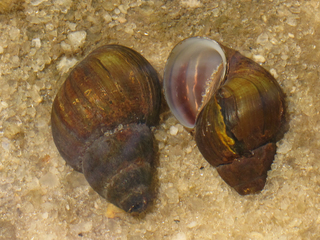
Classification
Scientific Name:
Cipangopaludina japonica (von Martens, 1861)
Latin Meaning: cipan=to keep. paludis=swamp, marsh (McCarthy,
2011).
dina and ica=feminine endings.
japonica refers to it's origination in Japan.
Common Name: Japanese
Mystery Snail
Snails within the family Viviparidae are called the mystery snails (Kohl,
2008). Cipangopaludina japonica originated
from Japan, giving this snail the common name of Japanese Mystery
Snail.
Domain: Eukarya
Kingdom: Animalia
Phylum: Mollusca
Class:
Gastropoda
Subclass: Prosobranchia
Order: Architaenioglossa
Family: Vivparidae
Genus: Cipangopaludina
Species: Cipangopaludina japonica
Domain Eukarya:
Members of this categorization contain eukaryotic cells and
membraneous organelles. Eukaryotic indicates that the organism
has a true nucleus. The presense of a true nucleus is what
differentiates Eukarya from the Archaea and the Eubacteria domains (Kaiser, 2011).
Kingdom Animalia:
This is a multicellular organism that does not contain cell walls or
photosynthetic pigments. The snail obtains their food through
heterotrophic means. They form a diploid blastula, which
organize into tissues, thus classifying them as animals (Myers,
2001).
Phylum Mollusca:
Mollusks are triploblastic acoelomates that attain bilateral
symmetry. Characteristics include the presence of a radula,
mantle, open circulatory system, and a complete digestive system,
which is complete with a mouth and an anus. Reproduction is
normally sexual. Mollusca typically has a ventral muscular
foot for means of locomotion. This phylum is found to live in
most environments (Ramel, 2002).
Class Gastropoda:
This class uses a muscular foot to move in a creeping motion.
The head is well-developed with eyes and tentacles. Most
species have a protective shell that is usually a spiral coil.
The gastropoda often has a operculum, which is a hard plate
structure that seals the opening when the snail draws its body into
their shell (Parsons, ed. 1997).
Subclass Prosobranchia:
This subclass signifies that the internal organs (gills, mantle
cavity and anus) are positioned in front of the heart. The
operculum is located on the dorsal surface of the muscular foot.
Torsion development occurs which places the anus and mantle cavity
both directly above the head, and the nerve cords forming in the
shape of a figure-8. The eyes are located at the base of the
tentacles (Fenner, 2000).
Order Architaenioglossa:
This order is united by the possession of a horny operculum, a thick
coiled shell, a pointy spire, and a shell that is medium to large in
size with at least four whorls. This order is up to 10 mm in
length (Ponder, 2001).
Family Viviparidae:
This family designation indicates they give birth to live small
snails instead of laying eggs. The male has a right tentacle
that is shorter and thicker than the left. The right tentacle
acts as a penis in the reproduction process (Animal
Diversity Web, 2000).

Genus Cipangopaludina:
The shell is comparatively larger than other organisms within
Architaenioglossa. The walls of the shell are thick.
Their operculum is thin and has concentric markings (Burch,
1980).
Species Cipangopaludina japonica:
Distinguished from other species because it has 7-8 whorls with the
spire at an angle between 50 and 55 degrees. The umbilicus is
very narrow and dark in color. As juveniles, they are lighter
in color and have hairs on the ridges of the shell. As adults,
they turn darker brown and the ridges are less pronounced (Jokinen,
1982).
To continue learning about this snail species, next view about their Habitat!